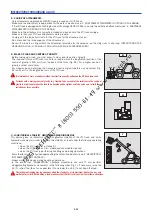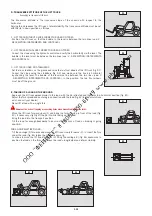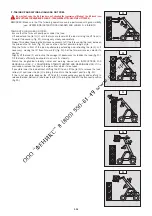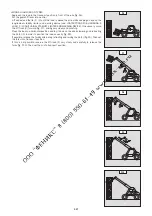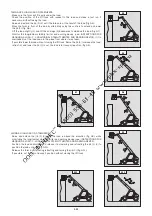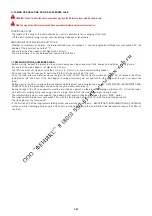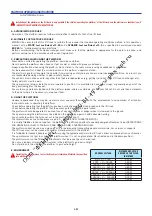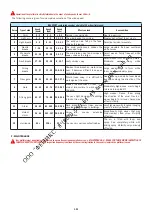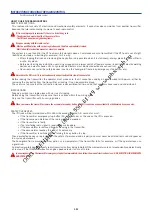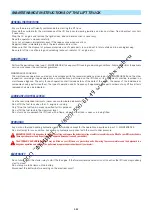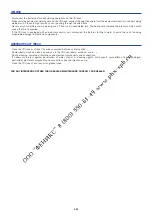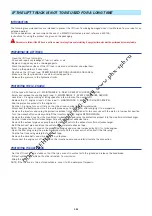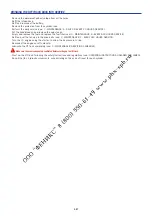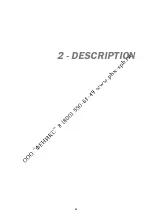
1-15
D - TRANSVERSE ATTITUDE OF THE LIFT TRUCK
Depending on the model of lift truck
The transverse attitude is the transverse slope of the chassis with respect to the
horizontal.
Raising the jib reduces the lift truck’s lateral stability. The transverse attitude must be set
with the jib in down position as follows:
1 - LIFT TRUCK WITHOUT SLOPE CORRECTOR USED ON TYRES
- Position the lift truck so that the bubble in the level is between the two lines (see: 2 -
DESCRIPTION: INSTRUMENTS AND CONTROLS).
2 - LIFT TRUCK WITH SLOPE CORRECTOR USED ON TYRES
- Correct the slope using the hydraulic control and verify the horizontality via the level. The
bubble in the level must be between the two lines (see: 2 - DESCRIPTION: INSTRUMENTS
AND CONTROLS).
3 - LIFT TRUCK USED ON STABILIZERS
- Set the two stabilizers on the ground and raise the two front wheels of the lift truck (fig. D1).
- Correct the slope using the stabilizers (fig. D2) and make sure the truck is horizontal
by checking the level. The bubble of the level must be between the two lines (see: 2
- DESCRIPTION: INSTRUMENTS AND CONTROLS). In this position, the two front wheels
must be off the ground.
E - TAKING UP A LOAD ON THE GROUND
- Approach the lift truck perpendicular to the load, with the jib retracted and the forks in a horizontal position (fig. E1).
- Adjust the fork spread and centering in connection with the load (fig. E2) (optional solutions
exist, consult your dealer).
- Never lift a load with a single fork.
Beware of the risks of trapping or squashing limbs when manually adjusting the forks.
- Move the lift truck for ward slowly (1) and bring the forks to stop in front of the load (fig.
E3), if necessar y, slightly lift the jib (2) while taking up the load.
- Bring the load into the transpor t position.
- Tilt the load far enough backwards to ensure stability (loss of load on braking or going
downhill).
FOR A NON-PALLETIZED LOAD
- Tilt the carriage (1) for wards and move the lift truck slowly for wards (2), to inser t the fork
under the load (fig. E4) (block the load if necessar y).
- Continue to move the lift truck for wards (2) tilting the carriage (3) (fig. E4) backwards to
position the load on the forks and check the load’s longitudinal and lateral stability.
D1
D2
E1
E2
1
2
E3
1
2
3
E4
Summary of Contents for MT 1058 R PRIVILEGE
Page 1: ......
Page 3: ......
Page 4: ...1 1 1 OPERATING AND SAFETY INSTRUCTIONS...
Page 5: ...1 2...
Page 31: ...1 28...
Page 32: ...2 1 2 DESCRIPTION...
Page 33: ...2 2...
Page 44: ...2 13...
Page 74: ...2 43...
Page 78: ...3 1 3 MAINTENANCE...
Page 79: ...3 2...
Page 84: ...3 7...
Page 92: ...3 15...
Page 104: ...3 27...
Page 116: ...4 1 4 OPTIONAL ATTACHMENTS FOR USE WITH THE RANGE...
Page 117: ...4 2...
Page 119: ...4 4...
Page 129: ...4 14...
Page 130: ...5 1 5 SPECIFIC CANADA...
Page 131: ...5 2...
Page 132: ...5 3 TABLE OF CONTENTS DIMENSIONS AND LOAD CHART MT 1058 R PRIVILEGE 5 4...
Page 135: ...5 6...
Page 136: ...6 1 6 SPECIFIC AUSTRALIA See also the operator s manual supplement 647065 AU...
Page 137: ...6 2...
Page 139: ...6 4...














